When I fish a small stream I'm content to go minimal; a fly box in my pocket, a lanyard full of tools, and a trusty small stream rod. But on bigger water I tend to go big. A fly box for every condition, clothing for changeable weather, snacks, lunch and a water bottle. I sometimes carry two rods and a spare spool as well. I need storage, lots of storage.
A few years ago I got into sling packs. They solved the problem of the waist pack, carried at dunkable levels, by moving storage higher up your back. They also keep the mass of stuff close to the body so that it's easier to carry and doesn't feel quite so heavy through a long day.
Most vendors have a "standard" model and a larger "guide" model. Because I'm a bit of a pack mule I've always gone for the guide versions.
I recently had an opportunity to spend time on the Delaware system wading and drifting with the new Orvis Safe Passage Guide Sling Pack. Overall, this pack is a big improvement on its predecessor. During a long weekend this pack spent time on my back, on the bottom of a drift boat and resting on the bank in the sun and the rain. It held a large streamer box that helped tempt a chunky Rainbow from a riffle, a box of small flies that provided just the right treat for a meaty brown and all the other angling gear for those just in case moments that didn't materialize. So how was it?
What Works
It's Big
Did I mention it holds lots of stuff? Half a dozen fly boxes, spare spool, numerous gadgets and supplies (e.g. split shot, strike indicators, leaders, spare tippet, etc), rain jacket, half a sandwich, beef jerky, two Snickers bars, cigar case, flask, camera, GoPro and there was room to spare.
Organization
Early packs were nothing more than large sacks. This model has good internal organization in the two main sections. The smaller section has four pockets sewn against the wall. Two of these are mesh so it's easy to see what's in them. The large section has a large zippered pocket with two mesh pockets sewn to it's outside. I found these smaller pockets just the right amount of space to stow the little things that can get lost at the bottom of a big pack. There's also an outside bottle pocket that will hold a one liter beverage. The interior fabric is brightly colored which makes seeing things in the pack a lot easier.
Waterproof Bottom
I tend to wade deep, usually when crossing a river, but also sometimes to get to the right spot for a cast. The waterproof bottom of the pack keeps things dry during the quick dunk. which also comes in handy when it's sitting on the deck of a drift boat with water sloshing around.
Stays Upright
This seems like a little thing but it was a major complaint with an earlier bag I had. This pack will sit upright in a boat or on the bank making access easy.
Stays in Place
I have another pack that I'm always hiking up as it swivels around my body during the day. Not so with the Safe Passage pack. This pack includes a short strap that clips under your arm so the pack stays out of the way when casting or moving.
What Doesn't
Lack of Internal Holders
The strap on the pack has plenty of storage for forceps and attachment points for zingers. However, my two bottles of floatant don't have an obvious home. Sure, this seem like quibbling, but it would be nice to have a place to reliably find those bottles. Perhaps a loop of webbing somewhere in one of the pockets.
No Waterproof Storage
With all the electronics we carry these days, including most car keys, it would be nice to have a secure place to store them. My car keys still ride in a ziploc. For an extra $12 Orvis will sell you a waterproof pocket that is designed to intergrate with the pack by attaching to one of the internal Velcro patches.
No Fly Patch
There's Velcro on the outside where you can stick your flies but I prefer a proper patch. For a gear junkie like me, that's not a problem. I have plenty of fly patches laying about but not everyone is as sick as me.
It's Big
The downside of this pack’s size is that you’re going to want to take a “kitchen sink” approach. Remember, you have to carry all that stuff. Carry too much and it will be heavy. Carry too little and you’ll kick yourself for not being prepared. Find the balance.
Final Word
Definitely a keeper. While there are some minor tweaks I'd make to the design, overall this bag makes it easy to spend a long day on big water.




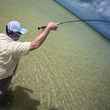


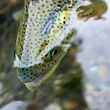



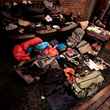




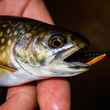



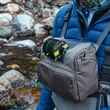





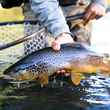




Comments
Mr. Terry replied on Permalink
I too am a deep wader and the pack kept my gear dry. Picked up the foam fly patch at Orvis which holds very well to the Velcro. Being a lefty, I thought that a sling pack would get in the way since it goes over the right shoulder. Not the case. Your right, it's a keeper but could use a few tweaks.
Aaron replied on Permalink
Are you able to attach a net to this sling pack? It seems to be the only downfall if you can't do this.
Rick Diffley replied on Permalink
RE: Safe Passage Guide Sling Pack - Where Does a Net Go?
Too bad there's not be a reply to this critical question. It is the major item that stops my from considering a sling pack, any kind.
What do you recommend and for those who have purchased this sling pack, where does one place a net?
If you some how hook to the slink pack, would it NOT get in the way when you swing the pack around to access items?
Stephen Zakur replied on Permalink
Yes, the sling pack has an attachment ring for a net on the sling.
Derek replied on Permalink
I know I'm a little late to the convo, but I just got this pack and found that the hole at the bottom of the water bottle pocket is the perfect size for a floatant bottle stored cap down through the hole. I can still fit my 24 oz Hydro Flask in the water bottle pocket above it. I don't know if this design is intentional, but it works perfectly.
The model I have is the normal Safe Passage, not the guide version, but I looked at both in the shop. Both sling over the left shoulder, so maybe this is a newer version than when this post went up.
Chris replied on Permalink
I have this pack and have only one issue with it: The tippet holder isn't conveniently placed. When I swing the pack around it would be easier if the tippet was right in front of me rather than low-left. With a rod in one hand on a right-handed sling it's not very easy to get to the spool. I have read lots of reviews on this sling and it doesn't seem like many have put it through thorough functional use and identified this problem.
Pages